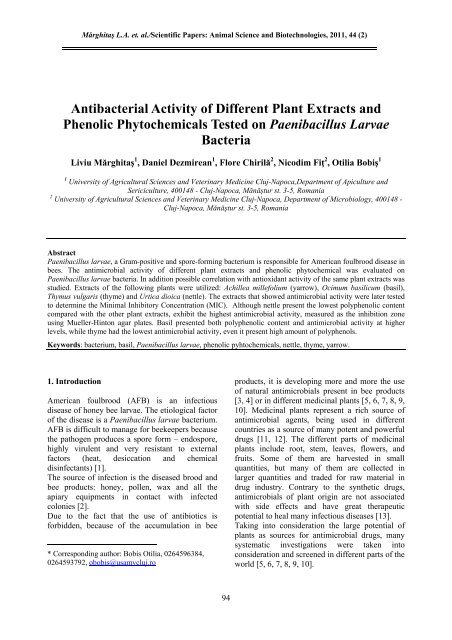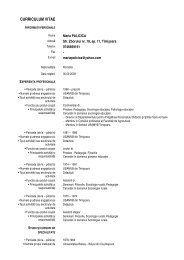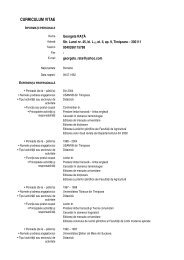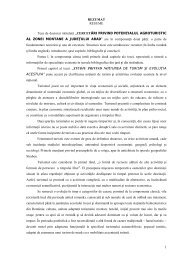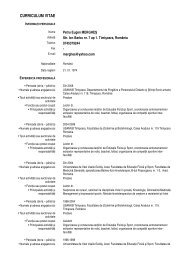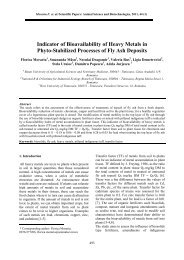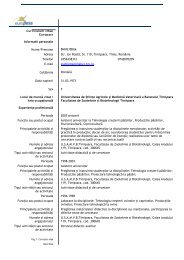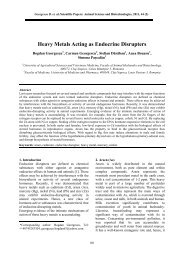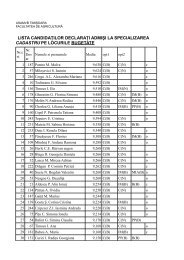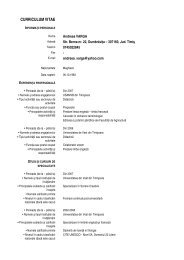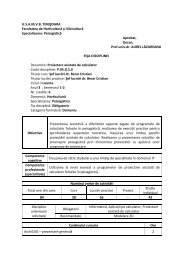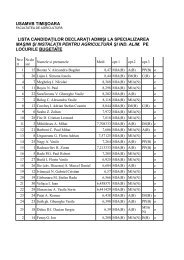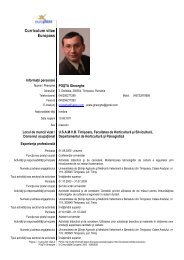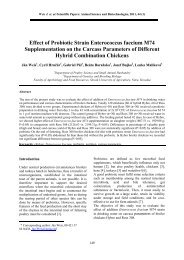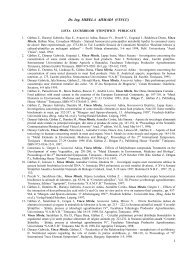Antibacterial Activity of Different Plant Extracts and Phenolic ...
Antibacterial Activity of Different Plant Extracts and Phenolic ...
Antibacterial Activity of Different Plant Extracts and Phenolic ...
Create successful ePaper yourself
Turn your PDF publications into a flip-book with our unique Google optimized e-Paper software.
Mărghitaş L.A. et. al./Scientific Papers: Animal Science <strong>and</strong> Biotechnologies, 2011, 44 (2)<br />
<strong>Antibacterial</strong> <strong>Activity</strong> <strong>of</strong> <strong>Different</strong> <strong>Plant</strong> <strong>Extracts</strong> <strong>and</strong><br />
<strong>Phenolic</strong> Phytochemicals Tested on Paenibacillus Larvae<br />
Bacteria<br />
Liviu Mărghitaş 1 , Daniel Dezmirean 1 , Flore Chirilă 2 , Nicodim Fiţ 2 , Otilia Bobiş 1<br />
1 University <strong>of</strong> Agricultural Sciences <strong>and</strong> Veterinary Medicine Cluj-Napoca,Department <strong>of</strong> Apiculture <strong>and</strong><br />
Sericiculture, 400148 - Cluj-Napoca, Mănăştur st. 3-5, Romania<br />
2 University <strong>of</strong> Agricultural Sciences <strong>and</strong> Veterinary Medicine Cluj-Napoca, Department <strong>of</strong> Microbiology, 400148 -<br />
Cluj-Napoca, Mănăştur st. 3-5, Romania<br />
Abstract<br />
Paenibacillus larvae, a Gram-positive <strong>and</strong> spore-forming bacterium is responsible for American foulbrood disease in<br />
bees. The antimicrobial activity <strong>of</strong> different plant extracts <strong>and</strong> phenolic phytochemical was evaluated on<br />
Paenibacillus larvae bacteria. In addition possible correlation with antioxidant activity <strong>of</strong> the same plant extracts was<br />
studied. <strong>Extracts</strong> <strong>of</strong> the following plants were utilized: Achillea millefolium (yarrow), Ocimum basilicum (basil),<br />
Thymus vulgaris (thyme) <strong>and</strong> Urtica dioica (nettle). The extracts that showed antimicrobial activity were later tested<br />
to determine the Minimal Inhibitory Concentration (MIC). Although nettle present the lowest polyphenolic content<br />
compared with the other plant extracts, exhibit the highest antimicrobial activity, measured as the inhibition zone<br />
using Mueller-Hinton agar plates. Basil presented both polyphenolic content <strong>and</strong> antimicrobial activity at higher<br />
levels, while thyme had the lowest antimicrobial activity, even it present high amount <strong>of</strong> polyphenols.<br />
Keywords: bacterium, basil, Paenibacillus larvae, phenolic pyhtochemicals, nettle, thyme, yarrow.<br />
1. Introduction<br />
American foulbrood (AFB) is an infectious<br />
disease <strong>of</strong> honey bee larvae. The etiological factor<br />
<strong>of</strong> the disease is a Paenibacillus larvae bacterium.<br />
AFB is difficult to manage for beekeepers because<br />
the pathogen produces a spore form – endospore,<br />
highly virulent <strong>and</strong> very resistant to external<br />
factors (heat, desiccation <strong>and</strong> chemical<br />
disinfectants) [1].<br />
The source <strong>of</strong> infection is the diseased brood <strong>and</strong><br />
bee products: honey, pollen, wax <strong>and</strong> all the<br />
apiary equipments in contact with infected<br />
colonies [2]. 1<br />
Due to the fact that the use <strong>of</strong> antibiotics is<br />
forbidden, because <strong>of</strong> the accumulation in bee<br />
* Corresponding author: Bobis Otilia, 0264596384,<br />
0264593792, obobis@usamvcluj.ro<br />
94<br />
products, it is developing more <strong>and</strong> more the use<br />
<strong>of</strong> natural antimicrobials present in bee products<br />
[3, 4] or in different medicinal plants [5, 6, 7, 8, 9,<br />
10]. Medicinal plants represent a rich source <strong>of</strong><br />
antimicrobial agents, being used in different<br />
countries as a source <strong>of</strong> many potent <strong>and</strong> powerful<br />
drugs [11, 12]. The different parts <strong>of</strong> medicinal<br />
plants include root, stem, leaves, flowers, <strong>and</strong><br />
fruits. Some <strong>of</strong> them are harvested in small<br />
quantities, but many <strong>of</strong> them are collected in<br />
larger quantities <strong>and</strong> traded for raw material in<br />
drug industry. Contrary to the synthetic drugs,<br />
antimicrobials <strong>of</strong> plant origin are not associated<br />
with side effects <strong>and</strong> have great therapeutic<br />
potential to heal many infectious diseases [13].<br />
Taking into consideration the large potential <strong>of</strong><br />
plants as sources for antimicrobial drugs, many<br />
systematic investigations were taken into<br />
consideration <strong>and</strong> screened in different parts <strong>of</strong> the<br />
world [5, 6, 7, 8, 9, 10].
Mărghitaş L. A. et. al./Scientific Papers: Animal Science <strong>and</strong> Biotechnologies, 2011, 44 (2)<br />
The aim <strong>of</strong> this study is to evaluate the effect <strong>of</strong><br />
natural compounds from different plant macerates<br />
against one strain <strong>of</strong> Paenibacillus larvae, an the<br />
evaluation <strong>of</strong> phenolic pr<strong>of</strong>ile in order to find a<br />
correlation between the chemical composition <strong>of</strong><br />
the tested plant extracts <strong>and</strong> their antibacterial<br />
activity.<br />
2. Materials <strong>and</strong> methods<br />
The plant materials used in this study were mature<br />
leaves <strong>and</strong> flowers <strong>of</strong> the following species:<br />
Yarrow (Achillea millefolium) belongs to the<br />
family Asteraceae. Is a herbaceous perennial plant<br />
that produces one to several stems <strong>and</strong> has a<br />
rhizomatous growth form. It has diaphoretic,<br />
astringent, tonic [14], anti-inflamatorry properties.<br />
Chemical composition comprises isovaleric <strong>and</strong><br />
salycilic acid, sterols, flavonoids, bitters, tannins,<br />
coumarins <strong>and</strong> proazulenes [15, 16].<br />
Basil (Ocimum basilicum) belongs to the family<br />
Lamiaceae. Chemical composition shows the<br />
presence <strong>of</strong> essential oils (linalool, estragol <strong>and</strong><br />
eugenol), tannins <strong>and</strong> flavonoids [15]. Scientific<br />
studies have demonstrated that compounds in basil<br />
have potent antioxidant, anticancer, antiviral <strong>and</strong><br />
antimicrobial properties [17, 18, 19].<br />
Nettle (Urtica dioica) belongs to the family<br />
Urticaceae, are mostly herbaceous perrenial<br />
plants, most <strong>of</strong> the speciaes having hairs on the<br />
stems <strong>and</strong> leaves. Chemical composition shows<br />
the presence <strong>of</strong> acetylcholine, histamine,<br />
serotonine, formic acid [20, 21].<br />
Thyme (Thymus vulgaris) belongs to the family<br />
Lamiaceae, <strong>and</strong> has as principal components <strong>of</strong><br />
chemical composition essential oils (thymol <strong>and</strong><br />
carvacol), flavonoids, tannins <strong>and</strong> triterpenes [15].<br />
Due to the high content <strong>of</strong> thymol(20-54% from<br />
the essential oil) it is used as antiseptic, antibiotic<br />
or antifungus.<br />
Ethanolic macerates <strong>of</strong> the above-described plants<br />
were obtained from 5 g dried plant <strong>and</strong> 100 ml<br />
70% ethanol. After 14 days <strong>of</strong> maceration at room<br />
temperature in the dark, stirring the content daily,<br />
extracts were filtered on filter paper <strong>and</strong> the final<br />
content was brought up to 100 ml with ethanol.<br />
The polyphenol content (mg/g) <strong>of</strong> the ethanol<br />
extracts was carried out according to Singleton et<br />
al.(1999) [22] using a modified Folin-Ciocalteu<br />
assay, which is sensitive to phenol <strong>and</strong> polyphenol<br />
entities as well as to other electro-donating<br />
antioxidants.<br />
95<br />
Briefly, 0.5 ml <strong>of</strong> the extracts were mixed with 2.5<br />
ml Folin–Ciocâlteu 0.2N reagent, for 5 minutes<br />
<strong>and</strong> than 2 ml <strong>of</strong> 75 g·l -1 sodium carbonate<br />
solutions was added. Samples were incubated at<br />
room temperature <strong>and</strong> in the dark for 2 hours, <strong>and</strong><br />
the absorbance <strong>of</strong> the mixture was read at 760 nm,<br />
against a blank consisting <strong>of</strong> methanol – Folin<br />
reagent <strong>and</strong> sodium carbonate.<br />
For the calibration curve, a stock solution <strong>of</strong> 1<br />
mg/ml Gallic acid was used, <strong>and</strong> successive<br />
dilutions, following the same protocol as<br />
described above, were read at 760 nm.<br />
The total polyphenol content was calculated using<br />
the following linear equation, based on the<br />
calibration curve: y = 8.03727x-0.06356,<br />
r 2 =0.9990.<br />
The total flavonoid content was determined using<br />
a method adapted by Arvonet-Gr<strong>and</strong> et al.(1994)<br />
[23], using a st<strong>and</strong>ard curve <strong>of</strong> Quercetin (0,5 –<br />
0,01 mg/ml)(y=11.11546x-0.00664; r 2 =0.9988)<br />
Briefly, 2 ml <strong>of</strong> extract was placed in a glass tube<br />
<strong>and</strong> 2 ml <strong>of</strong> aluminium chloride solution (2%) was<br />
added <strong>and</strong> mixed thoroughly <strong>and</strong> absorbtion<br />
readings at 415 nm using a Pharmaspech UV-<br />
1700, Shimadzu Spectrophotometer were taken<br />
against a blank sample. The flavonoid content was<br />
expressed as mg <strong>of</strong> quercetin equivalents (QE)/g,<br />
mean <strong>of</strong> three readings ± st<strong>and</strong>ard deviation.<br />
The High Performance Liquid Chromatography<br />
(HPLC) method, adapted after Bunea et al.(2008)<br />
[24], was used for the phenolic acid <strong>and</strong><br />
flavonoids determination, using a Shimadzu LC-<br />
10AD VP system, equipped with degasser, LC-10<br />
AD SP pumps, SIL-10 AF autosampler <strong>and</strong> SCL-<br />
10 A VP system controller with DAD SPD-M20A<br />
detector. Chromatographic separation was made<br />
on a Supelcosil LC-18 column (Ø 4.6 mm, 250<br />
mm length, 5 μm particle size) <strong>and</strong> Supelguard<br />
LC-18 2CM KIT guard column. Mobile phase:<br />
methanol:acetic acid:water (80:2:8)(solvent A)<br />
<strong>and</strong> methanol:acetic acid:water (10:3:73), flow<br />
rate 0.8 ml.min. <strong>Phenolic</strong> acids <strong>and</strong> flavonoid<br />
st<strong>and</strong>ards were dissolved in HPLC grade methanol<br />
(1 mg/ml solution), <strong>and</strong> diluted to perform the<br />
calibration curve on HPLC. Each st<strong>and</strong>ard was<br />
injected separately, to register the retention time<br />
<strong>and</strong> than in mixture, to see if all st<strong>and</strong>ards were<br />
baseline separated. Quantification was obtained by<br />
peak integration in comparison with st<strong>and</strong>ards.<br />
Results were expressed as mg/g dry plant.<br />
For „in vitro” testing <strong>of</strong> plant alcoholic<br />
macerates, an isolated strain <strong>of</strong> Paenibacillus
Mărghitaş L. A. et. al./Scientific Papers: Animal Science <strong>and</strong> Biotechnologies, 2011, 44 (2)<br />
larvae from a bee family contaminated with<br />
American foulbrood was used. In the first step,<br />
direct testing <strong>of</strong> antibacterial activity was carried<br />
out using the agar well diffusion method [25].<br />
Sterile Petri plates <strong>of</strong> 9 mm diameter with Brain<br />
Heart Infusion (BHI) broth with B1 vitamin<br />
supplementation were used for antibacterian<br />
activity against Paenibacillus larvae. Every dish<br />
contains approximately 15 ml BHI broth, in order<br />
to obtain a height <strong>of</strong> 5 mm in the plate.<br />
Wells (diameter <strong>of</strong> 5 mm) were punched in the<br />
afar following a radial model. The Petri plates<br />
were flooded with a bacterial suspension <strong>of</strong><br />
Paenibacillus larvae adjusted to a turbidity <strong>of</strong> 0.5<br />
MacFarl<strong>and</strong> st<strong>and</strong>ard scale (10 8 CFU/ml). With an<br />
automatic pipette, in every well 20 µl <strong>of</strong> analyzed<br />
sample were placed <strong>and</strong> thermostatated at 37 o C for<br />
48-72 hours. If the germ (Paenibacillus larvae<br />
bacterium) is sensitive to one <strong>of</strong> the tested<br />
extracts, an inhibition zone <strong>of</strong> variable dimension<br />
will be developed from the edges <strong>of</strong> the well. If<br />
the extract does not posses antibacterial activity,<br />
the bacterium will be multiplied until the edges <strong>of</strong><br />
the well.<br />
In the second stage <strong>of</strong> the experiment, minimal<br />
inhibitory concentration was determined following<br />
the successive dilutions method (broth micro<br />
dilution method). Sterile 96 wells micro titration<br />
plates, with 200 µl well capacity, were used, <strong>and</strong><br />
100 µl <strong>of</strong> the analyzed product (plant extract) were<br />
placed in the well, mixing with 100 µl <strong>of</strong> Mueller-<br />
Hinton broth. 100µl <strong>of</strong> every well is aspirated with<br />
the multichannel pipette <strong>and</strong> placed in the second<br />
column <strong>of</strong> the plate, adding another 100 µl <strong>of</strong><br />
broth. Successive dilutions are made in this way<br />
until the plate is full. For the last column 100 µl<br />
mixture is discharged. Each well is seeded in the<br />
end with 24 hours culture <strong>of</strong> Paenibacillus larvae<br />
<strong>and</strong> incubated for 48-72 hours at 37 o C.<br />
Minimal inhibitory concentration is given by the<br />
lowest dilution from the analyzed product, in<br />
which the development <strong>of</strong> the bacterium strain is<br />
inhibited (broth remain clear).<br />
3. Results <strong>and</strong> discussion<br />
<strong>Plant</strong> phenolics constitute one <strong>of</strong> the major groups<br />
<strong>of</strong> compounds responsible for antioxidant<br />
behavior, as well as for antimicrobial effects.<br />
Flavonoids, this diverse <strong>and</strong> widespread group <strong>of</strong><br />
natural compounds are the most important natural<br />
phenolics. They possess a broad spectrum <strong>of</strong><br />
96<br />
biological activities, including radical scavenging<br />
properties <strong>and</strong> antibacterial effect. Therefore, total<br />
phenol <strong>and</strong> flavonoid content in basil, nettle,<br />
thyme <strong>and</strong> yarrow was registered in ethanolic<br />
extracts (Figure 1). The content <strong>of</strong> phenolic<br />
compounds (mg GAE/g DW plant sample) was<br />
determined from regression equation <strong>of</strong> calibration<br />
curve <strong>and</strong> varied between 8.4 <strong>and</strong> 44.0 mg/g. The<br />
highest amount was registered in basil, followed<br />
by thyme <strong>and</strong> yarrow extract. Ethanolic extract <strong>of</strong><br />
nettle present the smaller quantity <strong>of</strong> polyphenols.<br />
The content <strong>of</strong> flavonoids (mgQE/g DW sample),<br />
determined from regression equation <strong>of</strong> calibration<br />
curve with quercetin, varied from 4.5 to 7.5 mg/g.<br />
The highest amounts <strong>of</strong> flavonoids were found in<br />
nettle <strong>and</strong> basil extracts. Lower quantities were<br />
registered in extracts <strong>of</strong> thymus <strong>and</strong> yarrow.<br />
50,0<br />
45,0<br />
40,0<br />
35,0<br />
30,0<br />
25,0<br />
20,0<br />
15,0<br />
10,0<br />
5,0<br />
0,0<br />
44,0<br />
7,1<br />
Total polyphenols (mg/g dry<br />
plant)<br />
Flavone/flavonols (mg/g dry<br />
plant)<br />
27,0<br />
8,4<br />
7,5<br />
23,4<br />
4,9 4,5<br />
Ocimum basilicum Urtica dioica Thymus vulgaris Achillea<br />
millefolium<br />
Figure 1. Total phenolic <strong>and</strong> flavone/flavonols content<br />
in plant macerates<br />
HPLC determinations <strong>of</strong> phenolic acid <strong>and</strong><br />
flavonoid pr<strong>of</strong>ile revealed the presence <strong>of</strong><br />
phenolic acids in higher quantities than flavonoid<br />
aglicones (Table 1). It is well known that plant<br />
extracts exhibit high quantities <strong>of</strong> flavonoid<br />
glycosides, <strong>and</strong> as our research was carried out on<br />
alcoholic macerates without hydrolization, only<br />
rutin was identified <strong>and</strong> quantified from the<br />
extracts.<br />
From basil macerate we could identify <strong>and</strong><br />
quantify a high quantity <strong>of</strong> rosmarinic acid (29.4<br />
mg/g dry plant), as in nettle extract (29.2 mg/g).<br />
These two macerates present also a high amount<br />
<strong>of</strong> ferulic acid (3.17 <strong>and</strong> 3.09 mg/g respectively)<br />
<strong>and</strong> rutin (3.77 <strong>and</strong> 3.16 mg/g). In basil extract<br />
was quantified also caffeic acid (1.20 mg/g), same<br />
as in nettle extract (1.23 mg/g). Small quantity <strong>of</strong><br />
chlorogenic acid was also quantified in nettle<br />
extract (0.71 mg/g).
Mărghitaş L. A. et. al./Scientific Papers: Animal Science <strong>and</strong> Biotechnologies, 2011, 44 (2)<br />
Table 1. Identified <strong>and</strong> quantified plenolic acids <strong>and</strong> flavonoids in plant macerates (mg/g dry plant)<br />
Vegetal species Clorogenic Caffeic acid Ferulic acid Rutin Rosmarinic<br />
acid<br />
acid<br />
Basil (Ocimum basilicum) 0.00 1.20 3.17 3.77 29.40<br />
Nettle (Urtica dioica) 0.71 1.23 3.09 3.16 29.20<br />
Thyme (Thymus vulgaris) 1.90 1.30 0.00 10.10 9.20<br />
Yarrow (Achillea millefolium) 0.01 0.46 0.00 7.36 7.96<br />
Thyme <strong>and</strong> yarrow extracts present smaller<br />
quantities <strong>of</strong> rosmarinic acid (9.2 <strong>and</strong> 7.96 mg/g<br />
respectively) <strong>and</strong> no ferulic acid. Rutin was<br />
quantified in the highest amount in thyme extract<br />
(10.1 mg/g, followed by yarrow extract (7.36<br />
mg/g) <strong>and</strong> the already named basil <strong>and</strong> nettle<br />
extracts. Thyme extract exhibit chlorogenic <strong>and</strong><br />
caffeic acid (1.9 <strong>and</strong> 1.3 mg/ml respectively),<br />
meanwhile yarrow extract present smaller<br />
quantities <strong>of</strong> chlorogenic (0.01 mg/g) <strong>and</strong> caffeic<br />
acid (0.46 mg/g).<br />
All plants assigned in this study are used as<br />
medicinal plants in Romania for human<br />
consumption, but also as adjuvants in bee feeding.<br />
Previous studies [26, 27], showed that nettle<br />
extract (Urtica dioica) may have potential in bee<br />
disease prevention <strong>and</strong> colony development. The<br />
antibacterial activity <strong>of</strong> specific concentrations <strong>of</strong><br />
alcoholic extracts for the studied plants is shown<br />
in Table 2.<br />
Table 2. Inhibition growth <strong>of</strong> different plant macerates<br />
<strong>and</strong> minimal inhibitory concentration (MIC) against<br />
Paenibacillus larvae bacterium<br />
Inhibition area<br />
Vegetal species<br />
1<br />
(mm) MIC 3<br />
Control (ppm)<br />
2 <strong>Plant</strong><br />
macerates<br />
Basil (Ocimum<br />
basilicum)<br />
0 17 0.195<br />
Nettle (Urtica<br />
dioica)<br />
0 21 0.195<br />
Thyme (Thymus<br />
vulgaris)<br />
0 11 1.562<br />
Yarrow (Achillea<br />
millefolium)<br />
0 11 0.781<br />
1 Numbers represent the average diameter (in mm) <strong>of</strong><br />
the inhibition zone<br />
2 Ethanol 70% was used as negative control<br />
3 Minimal inhibitory concentration <strong>of</strong> plant extracts<br />
Using agar well diffusion method, highest<br />
antibacterial activity was registered for nettle<br />
extract (21 mm diameter inhibition zone)(Figure<br />
2), followed by basil extract (17 mm inhibition<br />
zone). Thyme <strong>and</strong> yarrow macerates show weak<br />
97<br />
inhibition activity with only 11 mm diameter <strong>of</strong><br />
the inhibition zone. Regarding the minimum<br />
inhibitory concentration (MIC), again basil <strong>and</strong><br />
nettle macerates exhibit better results, growth<br />
inhibition <strong>of</strong> the bacterium Paenibacillus larvae<br />
was observed until a concentration <strong>of</strong> 0.195 ppm,<br />
thyme extract needs a higher concentration for<br />
inhibition <strong>of</strong> the bacterium (1.562 ppm) <strong>and</strong><br />
yarrow extract 0.781 ppm. Even though, the<br />
chosen plants are good antibacterians against<br />
Paenibacillus larvae development.<br />
Figure 2. Inhibition zone for the plant macerates using<br />
difuzimetric method for Paenibacillus larvae; 1-<br />
Ocimum basilicum extract; 2-Urtica dioica extract; 3-<br />
Thymus vulgaris extract; 4-Achillea millefolium<br />
extract<br />
4. Conclusions<br />
<strong>Plant</strong>s are very important sources <strong>of</strong> potential<br />
useful raw materials for the new development <strong>of</strong><br />
natural chemotherapeutic agents. Many reports are<br />
available on the antiviral, antibacterial, antifungal<br />
or anti-inflamatory properties <strong>of</strong> plants [5, 6, 7, 8,<br />
9, 10, 28, 29, 30, 31 32]. These studies have<br />
helped in identifying the active principles
Mărghitaş L. A. et. al./Scientific Papers: Animal Science <strong>and</strong> Biotechnologies, 2011, 44 (2)<br />
responsible for the mentioned activities <strong>and</strong> some<br />
<strong>of</strong> the studied plants are used as ingredients in<br />
different drugs used in human <strong>and</strong> animal cure.<br />
Our study indicate that the plants we took into<br />
consideration (basil, nettle, thyme <strong>and</strong> yarrow)<br />
have the potential to copntrol the growth <strong>of</strong><br />
Paenibacillus larvae in vitro at the concentrations<br />
established by the microbiological methods. The<br />
use <strong>of</strong> the biologically active compounds from<br />
these plants could represent a natural alternatiove<br />
to antibiotic treatments on honeybees, in<br />
controlling American foulbrood disease, produced<br />
by Paenibacillus larvae bacterium.<br />
Beside their inhibitory effect, the plant macerates<br />
also have low toxicity to bees, acting like nutritive<br />
supplements in bee colony development.<br />
Acknowledgements<br />
Financial support by the National Authority <strong>of</strong><br />
Scientific Research, Project POS CCE –<br />
618/12460/2010<br />
References<br />
1. Thompson, T. S., Pernal, S. F., Noot, D. K.,<br />
Melathopoulos, A. P., van der Heever, J. P.,<br />
Degradation <strong>of</strong> the incurred tylosin to desmycosin –<br />
implications for residue analysis <strong>of</strong> honey, Analitica<br />
Chimica Acta, 2007, 586, 304-311<br />
2. Mutinelli, F., European legislation governing the<br />
authorization <strong>of</strong> veterinary medical products with<br />
particular reference to the use <strong>of</strong> drugs for the control<br />
<strong>of</strong> honey bee diseases, Apiacta, 2003, 38, 156-168<br />
3. Antunuez, K., Harriet, J., Gende, L., Maggi, M.,<br />
Eguaras, M., Zunino, P., Efficacy <strong>of</strong> natural propolis<br />
extract in the control <strong>of</strong> American Foulbrood,<br />
Veterinary Microbiology, 2008, 131, 324-331<br />
4. Damiani, N., Fern<strong>and</strong>ez, N. J., Maldonado, L. M.,<br />
Alvarez, A. R., Eguaras, M. J., Marcangeli, J. A.,<br />
Bioactivity <strong>of</strong> propolis from different geographical<br />
origins on Varroa destructor (Acari: Varroidae),<br />
Parasitological Research, 2010, 107, 31-37<br />
5. Nascimento, G. G. F., Locatelli, J., Freitas, P. C.,<br />
Silva, G. L., <strong>Antibacterial</strong> activity <strong>of</strong> plant extracts <strong>and</strong><br />
phytochemicals on antibiotic resistant bacteria,<br />
Brasilian Journal <strong>of</strong> Microbiology, 2000, 31, 247-256<br />
6.Gende, L. B., Floris, I., Fritz, R., Eguaras, M. J.,<br />
Antimicrobial activity <strong>of</strong> cinnamon (Cinnamonum<br />
zeylanicum) essential oil <strong>and</strong> its main components<br />
against Paenibacillus larvae from Argentina, Bulletin<br />
<strong>of</strong> Insectology, 2008, 61(1), 1-4<br />
7. Ghosh, A., Kanti Das, B., Roy, A., M<strong>and</strong>al, B.,<br />
Ch<strong>and</strong>ra, G., <strong>Antibacterial</strong> activity <strong>of</strong> some medicinal<br />
98<br />
plant extracts, Journal <strong>of</strong> Natural Medicine, 2008, 62,<br />
259-262<br />
8. Damiani, N., Gende, L. B., Bailac, P., Marcangeli, J.<br />
A., Eguaras, M. J., Acaricidal <strong>and</strong> insecticidal activity<br />
<strong>of</strong> essential oils on Varroa destructor (Acari:<br />
Varroidae) <strong>and</strong> Apis mellifera (Hymenoptera: Apidae),<br />
Parasitology Research, 2009, 106, 145-152<br />
9. Flesar, J., Havlik, J., Kloucek, P., Rada, V., Titera,<br />
D., Bednar, M., Stropnicky, M., Kokoska, L., In vitro<br />
growth-inhibitory effect <strong>of</strong> plant-derived extracts <strong>and</strong><br />
compounds against Paenibacillus larvae <strong>and</strong> their acute<br />
oral toxicity to adult honey bees, Veterinary<br />
Microbiology, 2010, 145, 129-133<br />
10. Damiani, N., Gende, L. B., Maggi, M. D., Palacios,<br />
S., Marcangeli, J.A., Eguaras, M.J., Repellent <strong>and</strong><br />
acaricidal effects <strong>of</strong> botanical extracts on Varroa<br />
destructor, Rarasitology Research, 2011, 108, 79-86,<br />
11. Srivastava, J., Lambert, J., Vietmeyer, N.,<br />
Medicinal plants: An exp<strong>and</strong>ing role, 1996<br />
12. Lewis, K., Ausubel, F. M., Prospects for plantderived<br />
antibacterials, Nature Biotechnology, 2006, 24,<br />
1504-1507<br />
13. Iwu, M. W., Duncan, A. R., Okunji, C. O., New<br />
antimicrobials <strong>of</strong> plant origin. In: Janik J.<br />
(ed.):Perspectives on New Crops <strong>and</strong> New Uses. ASHS<br />
Press, Alex<strong>and</strong>ria, VA, 457-462<br />
14. Hutchens, A., Indian Herbology <strong>of</strong> North America,<br />
Shambhala Publications, 1973<br />
15. Bisset, N. M., Herbal Drugs <strong>and</strong><br />
Phytopharmaceuticals, CRC Press London, 1994, 566<br />
16. Ch<strong>and</strong>ler, R. F., Hooper, S. N., Harvgey, M. J.,<br />
Ethnobotany <strong>and</strong> phytochemistry <strong>of</strong> yarrow, Achillea<br />
millefolium, Compositae, Economic Botany, 1982, 36,<br />
203-223<br />
17. Bozin, B., Mimica-Dukic, N., Simin, N., Anackov,<br />
G., Characterization <strong>of</strong> the volatile composition <strong>of</strong><br />
essential oils <strong>of</strong> some Lamiaceae spices <strong>and</strong> the<br />
antimicrobial <strong>and</strong> antioxidant activities <strong>of</strong> the entire<br />
oils, Journal <strong>of</strong> Agricultural <strong>and</strong> Food Chemistry, 2006,<br />
54(5), 1822–8<br />
18. Chiang, L. C., Ng, L. T., Cheng, P. W., Chiang, W.,<br />
Lin, C. C., Antiviral activities <strong>of</strong> extracts <strong>and</strong> selected<br />
pure constituents <strong>of</strong> Ocimum basilicum, Clinical <strong>and</strong><br />
Experimental Pharmacology <strong>and</strong> Physiology, 2005,<br />
32(10), 811–816<br />
19. de Almeida, I., Alviano, D. S., Vieira, D. P., et al.,<br />
Antigiardial activity <strong>of</strong> Ocimum basilicum essential oil,<br />
Parasitology Research, 2007, 101(2), 443–452<br />
20. Casarett, L. J., Klaassen, C. D., Doull, J., Casarett<br />
<strong>and</strong> Doull’s toxicology: the basic science <strong>of</strong> poisons,<br />
McGraw-Hill Pr<strong>of</strong>essional, 2008, 1104<br />
21. Greenberg, M. I., Occupational, industrial <strong>and</strong><br />
environmental toxicology, Elsevier Health Sciences,<br />
2003, 180<br />
22. Singleton, V. L., Orth<strong>of</strong>er, R., Lamuela-Raventos,<br />
R. M., Analysis <strong>of</strong> total phenolics <strong>and</strong> their oxidation<br />
substrates <strong>and</strong> antioxidants by means <strong>of</strong> Folin-
Mărghitaş L. A. et. al./Scientific Papers: Animal Science <strong>and</strong> Biotechnologies, 2011, 44 (2)<br />
Ciocalteu reagent, Methods in Enzymology, 1999, 299,<br />
152-178<br />
23. Arvouet-Gr<strong>and</strong>, A., Vennat, B., Pourrat, A.,<br />
Legret, P., St<strong>and</strong>ardization <strong>of</strong> propolis extract <strong>and</strong><br />
identification <strong>of</strong> principal constituents, Journal de<br />
Pharmacie de Belgique, 1994, 4 , 462–468<br />
24. Bunea, A., Andjelkovic, M., Socaciu, C., Bobiş, O.,<br />
Neacşu, M., Verhe, R., van Camp, J., Total <strong>and</strong><br />
individual carotenoids <strong>and</strong> phenolic acids content in<br />
fresh, refrigerated <strong>and</strong> processed spinach (Spinacia<br />
oleracea L.), Food Chemistry, 2008, 108, 649-656<br />
25. Perez, C., Bazerque, P. M., Antibiotic assay by<br />
agar-well diffusion method, Acta Biol Med Exp, 1990,<br />
15, 113-115<br />
26. Mărghitaş, L., Bobiş, O., T<strong>of</strong>alvi, M., The effect <strong>of</strong><br />
<strong>Plant</strong> supplements on the development <strong>of</strong> Artificially<br />
weaken bee families, Scientific papers: Animal Science<br />
<strong>and</strong> Biotechnologies, 2010, 43(1)<br />
27. Pohorecka, K., Effect <strong>of</strong> st<strong>and</strong>ardized plant extracts<br />
on general condition <strong>of</strong> the honeybee (Apis mellifera<br />
L.), Bulletin <strong>of</strong> Veterinary Institute in Pulawy, 2004,<br />
48, 415-419<br />
99<br />
28. Samy, R. P., Ignacimuthu, S., <strong>Antibacterial</strong> activity<br />
<strong>of</strong> some folklore medicinal plants used by tribals in<br />
Western Ghats in India, Journal <strong>of</strong> Ethnopharmacology,<br />
2000, 69, 63-71<br />
29. Palombo, E. A., Seple, S. J., <strong>Antibacterial</strong> activity<br />
<strong>of</strong> traditional medicinal plants, 2001, Journal <strong>of</strong><br />
Ethnopharmacology, 77, 151-157<br />
30. Kumaraswamy, Y, Cox, P. J., Jaspars, M., Nahar,<br />
L, Sarker, S. D., Screening seeds <strong>of</strong> Scotish plants for<br />
antibacterial activity, Journal <strong>of</strong> Ethnopharmacology,<br />
2002, 83, 73-77<br />
31.Stepanovic, S., Antic, N., Dakic, I., Svabicvlahovic,<br />
In vitro antimicrobial activity od propolis <strong>and</strong><br />
antimicrobial drugs, Microbiological Research, 2003,<br />
158, 353-357<br />
32.Bylka, W., Szaufer-Hajdrych, M., Matalawskan, I.,<br />
Goslinka, O., Antimicrobial activity od isocytisoside<br />
<strong>and</strong> extracts <strong>of</strong> Aquilegia vulgaris L., Letter in Applied<br />
Microbiology, 2004, 39, 93-97


